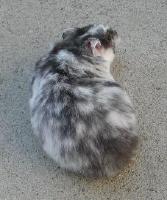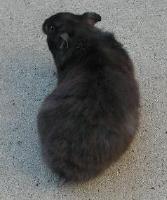I am searching for a breeding mate for Polly, one of my Black Dominant Spot females (aaDsdsPp). It will be her last litter due to her age. She has had two prior litters, and both were small litters. My goal is to keep one or two of her daughters to continue the line since it is one of my best. Four of the five females on her mother's side are Best in Show winners. She also won BIS in February. So I want a show quality daughter. My preference is to keep a Black Dominant Spot daughter like her although I have to be open to other colors.
Let’s evaluate her and then evaluate the males I could mate her to.
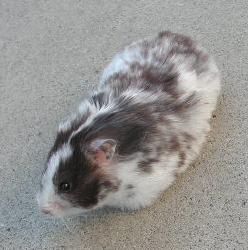
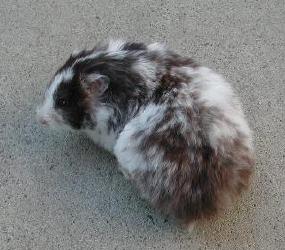
Polly has a full face but is too narrow in her head which is most evident by the lack of width between her ears. She is very large in size (length) and has a good solid body. She’s a bit narrow in the shoulders. Her pattern is relatively good although that will not necessarily be passed on to the babies. She is starting to brown, but that is not uncommon at her age. Her fur density is very good. Her eyes are a bit small.
The trait that I consider most important to improve is her head structure. The dominant spot markings accentuate the problem, but I’d like to see a wider and shorter head. The traits I most want to maintain are her size (length) and stocky body. Both are among the best I see in my own animals and on the show bench.
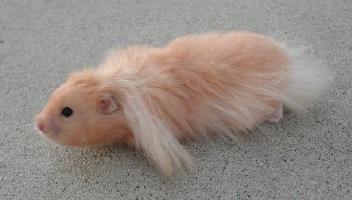
Honey Bear is one of the larger males I’ve seen and has a good, stocky build with fairly good type. He also has a better than average head in width and bluntness. His coat has always been interesting. This shot of him shows him when he only had a few long tufts. At times, he has more consistent long fur across the back and sides too. Regardless, his coat is generally uneven with varying lengths although it is very long at some points. This will probably not carry directly through to the females, but I would like their male sons to have good, long, and even coats.
Color is a big issue with Honey Bear. Honey Bear is a Honey Black potentially also Light Gray. I am still confirming that, but one of his other litters indicates that he may be Light Gray, and his father was a Light Gray Pearl (AaLglgToY). His lack of ticking and color would lend support to him being Lglg.
I would like to stick to Black and Black Dominant Spot colors in this line because the introduction of other colors even if carried could affect the color or darkness of the blacks produced. I know that Polly carries Cinnamon. If I bred these two, the females I would get would be about equal numbers of Dove Tortoiseshells, Dove Tri Colors, Black Tortoiseshells, and Black Tri Colors instead of my preferred Black and Black Dominant Spots. Lastly, if Honey Bear is also Light Gray, Light Gray plus Black is believed to produce a poorer black color (sometimes called “dingy black”). Since I expect a small litter without a lot to choose from, I’d rather not use Honey Bear with all of the added genes and uncertainty he adds to the mix.
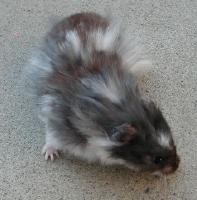
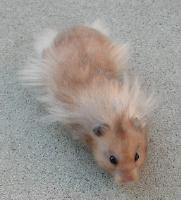
Spot is medium in size, and his head is rather pointed. His fur length has never been good, and his coat is very uneven. His fur density is a bit above average. One of my concerns with him is that the litter will be about 25% smaller due to the Dominant Spot to Dominant Spot mating (approximately 25% will not be born). Since I expect the litter to be small anyway (due to her litter history and age), I hate to risk losing any more. I would like at a least a few females to choose from.
Yellow Black Male “Henry” (aaPpTo-)
Henry was quickly eliminated. He has the same problem head structure that Polly has, and this was one of my key criteria. Although he has full cheeks, he has a narrow head shown by the lack of ear width. Since I specifically wanted to work on this trait with this breeding, I have eliminated him. He is not spectacular in other ways, either.
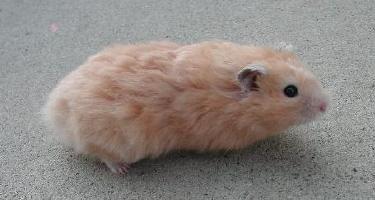
I decided to investigate another option since I wasn’t impressed with the above options. There is a Cream male who I often judge at our shows. He belongs to one of our youths. I bred him, and I wish I had kept him. He is a very nice male. He has won Best in Show as well as Best Pet at multiple shows. He is one of those very well-rounded hamsters who has a lot of strengths and few weaknesses. I decided to see if Katelyn would allow me to borrow him for a couple of weeks. He is purely a pet to her and has never been bred. He is about a year and a half. She agreed. So I will have him for a couple of weeks to breed to as many females as I’d like. Katelyn has only asked for one of his sons to replace a hamster who recently died.
Mr. Nibbles is medium to large in size. He has good type and a very good head. He has good width between the ears which is one of my main criteria for this breeding. He has extremely good coat density (even though he is aging) and a very even coat. His coat is not as long as it should be for a male. That is his main weakness in showing. He has beautiful large eyes which compliment Polly’s small eyes. He has excellent temperament.
His color is a weakness. I have worked to get the Cream out of my Black lines. I have a number of Yellow Blacks which I use in breedings, and it can be difficult in the US to separate Cream from bad Yellow or Yellow Black, so it is best to keep the lines entirely separate. It is mostly out of my lines now, but this will re-introduce it. This would only create further problems, particularly given my accidental introduction of Cinnamon into my Black lines (breeder didn’t warn me about this). Both of these detract from my personal goals, but I have accepted the fact that it is very difficult to maintain pure color lines in my current environment unless I totally lock off my hamstery – and I don’t want to do that. The good thing is that Polly doesn’t carry cream, so I have a good probability of getting Black and/or Black Dominant Spot females from this pairing even if they will all carry cream.
Match
6
4
4
6
Density
7
7
7
6
8
Length
4
5
4
6
(Length)
8
6
7
6
6
Structure
7
5
7
5
7
Structure
6
5
7
5
8
Spot
Honey Bear
Henry
Mr. Nibbles
It is quite easy to see why Spot and Henry were eliminated. The decision was between Honey Bear and Mr. Nibbles.
Mr. Nibbles is stronger in my key criterion: head structure. He is also stronger in fur density. Honey Bear has the edge in body size and shape. He’s a bit bigger with more bulk to him. The leaning is toward Mr. Nibbles.
The clincher, though, was the color. Although I didn’t want to add Cream back into my lines, I was more averse to ensuring that all females would be Tortoiseshells or Tri-colors. This line has not produced Torts or Tris with enough Yellow to be show quality. Thus, if I used Honey Bear, I would have a low probability of getting a show quality daughter to continue the BIS line. The only break in the BIS chain so far was a poorly marked Tortoiseshell who worked great as a breeder but di not have the markings for a BIS hamster.
If I bred Polly to Mr. Nibbles, however, I had a good chance of getting a show quality Black or Black Dominant Spot daughter, and that was my ultimate goal. A Tort or Tri (Black or Dove) with the same strengths would just be a breeder with the potential of producing show quality sons or daughters. In the absence of Mr. Nibbles, though, I would have used Honey Bear and kept the strongest daughter as far as the above criteria regardless of markings.
Results
Below are the two daughters I kept from this mating. They are only about 2 months old now, but I got what I wanted as far as color. Polly had five babies. I kept the Black and the Black Dominant Spot daughters. The Black was actually the pick of the litter and has the stronger head and ear width -- at least so far. Both have their mother's stocky build. I hope that they both fill out a bit in the shoulders. I will attach more pictures as they mature -- particularly of their heads.
